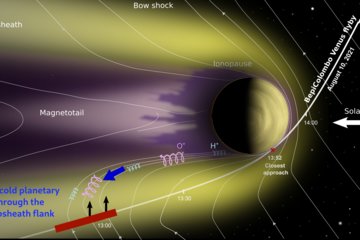All genres
81.
Journal Article
Coronal waves: propagation in the multi-fluid description. Philosophical Transactions of the Royal Society A 364 (1839), pp. 537 - 540 (2006)
82.
Journal Article
Radial evolution of the electron distribution functions in the fast solar wind between 0.3 and 1.5 AU. Journal Geophysical Research 110, A09104 (2005)
83.
Journal Article
The relativistic energy spectrum of hydrogen. Annalen der Physik 14 (5), pp. 324 - 343 (2005)
84.
Journal Article
Solar Orbiter-mission profile, main goals and present status. Advances in Space Research 36, pp. 1360 - 1366 (2005)
85.
Journal Article
Correlation heights of the sources of solar ultraviolet emission lines in a quiet-sun region. Astrophysical Journal 624, pp. L133 - L136 (2005)
86.
Journal Article
Solar wind origin in coronal funnels. Science 308, pp. 519 - 523 (2005)
87.
Journal Article
Links between magnetic fields and plasma flows in a coronal hole. Astronomy and Astrophysics 432, pp. L1 - L4 (2005)
88.
Journal Article
On the nature of the unidentified solar emission near 117 nm. Astronomy and Astrophysics 439, pp. 701 - 711 (2005)
89.
Journal Article
On the temperature anisotropy of the core part of the proton velocity distribution function in the solar wind. Journal Geophysical Research 109, A04102 (2004)
90.
Journal Article
Coronal plasma flows and magnetic fields in solar active regions Combined observations from SOHO and NSO/Kitt Peak. Astronomy and Astrophysics 428, pp. 629 - 645 (2004)
91.
Journal Article
Dependence of the proton beam drift velocity on the proton core plasma beta in the solar wind. Journal Geophysical Research 109, A05101 (2004)
92.
Journal Article
Observations of the Sun at vacuum-ultraviolet wavelengths from space. Part I: Concepts and instrumentation. Space Science Reviews 111, pp. 415 - 480 (2004)
93.
Journal Article
On the network structures in solar equatorial coronal holes - Observations of SUMER and MDI on SOHO. Astronomy and Astrophysics 424, pp. 1025 - 1037 (2004)
94.
Journal Article
On ion-cyclotron-resonance heating of the corona and solar wind. Nonlinear Processes in Geophysics 10, pp. 101 - 112 (2003)
95.
Journal Article
A possible way of understanding the differential motion of minor ions in the solar wind. Journal Geophysical Research 108 (A4), 1161 (2003)
96.
Journal Article
Slow-mode standing waves observed by SUMER in hot coronal loops. Astronomy and Astrophysics 402, pp. L17 - L20 (2003)
97.
Journal Article
On the outflow in an equatorial coronal hole. Astronomy and Astrophysics 399, pp. L5 - L9 (2003)
98.
Journal Article
On resonant interactions of ions with plasma waves in a reduced quasi-linear theory. Nonlinear Processes in Geophysics 9, pp. 69 - 74 (2002)
99.
Journal Article
Solar Orbiter, a high-resolution mission to the Sun and inner heliosphere. Advances in Space Research 29, pp. 2027 - 2040 (2002)
100.
Journal Article
Anisotropy regulation and plateau formation through pitch-angle diffusion of solar wind protons in resonance with cyclotron waves. Journal Geophysical Research 107 (A9), 1249 (2002)











